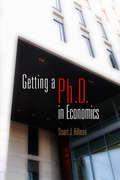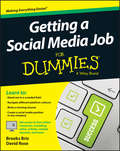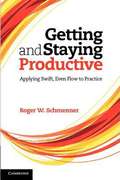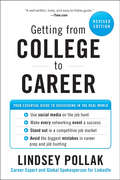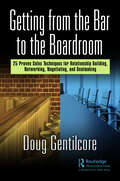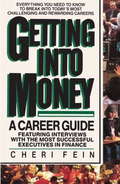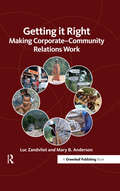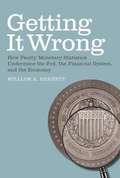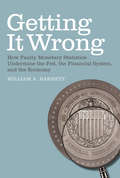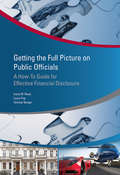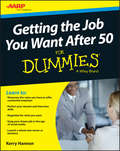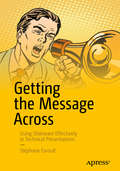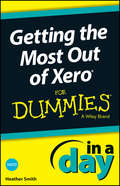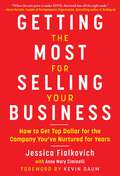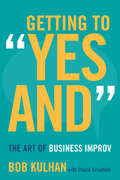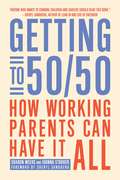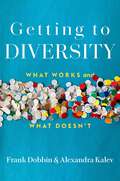- Table View
- List View
Getting a Ph.D. in Economics
by Stuart J. HillmonConsidering a graduate degree in economics? Good choice: the twenty-first-century financial crisis and recession have underscored the relevance of experts who know how the economy works, should work, and could work. However, Ph.D. programs in economics are extremely competitive, with a high rate of attrition and a median time of seven years to completion. Also, economic professions come in many shapes and sizes, and while a doctoral degree is crucial training for some, it is less beneficial for others. How do you know whether a Ph.D. in economics is for you? How do you choose the right program--and how do you get the right program to choose you? And once you've survived years of rigorous and specialized training, how do you turn your degree into a lifelong career and meaningful vocation?Getting a Ph.D. in Economics is the first manual designed to meet the specific needs of aspiring and matriculating graduate students of economics. With the perspective of a veteran, Stuart J. Hillmon walks the reader though the entire experience--from the Ph.D. admissions process to arduous first-year coursework and qualifying exams to armoring up for the volatile job market. Hillmon identifies the pitfalls at each stage and offers no-holds-barred advice on how to navigate them. Honest, hard-hitting, and at times hilarious, this insider insight will equip students and prospective students with the tools to make the most of their graduate experience and to give them an edge in an increasingly competitive field.
Getting a Social Media Job For Dummies
by David Rose Brooks BrizYour no-nonsense guide to getting a job in social media Looking to snag a social media position? This fun and practical guide shows you how to stand out from the competition and land your dream job in social media. Inside, you'll find expert and easy-to-follow guidance on where you should look for a job in social media, how to research companies to target, the social media sites where you should be active, and much more. Plus, you'll get resume and cover letter writing tips, answers to tricky interview to woo potential employers, and advice on creating a valuable social media position within your current company. You will also benefit from sample resumes, resume templates, and videos available to download and view online. From SEO specialists to online community managers, social media positions are the latest buzz in the job market. As businesses have come to value the competitive edge that a strong social media presence can offer, these jobs have quickly evolved from short-term, peripheral positions to highly sought-after careers. With the help of Getting a Social Media Job For Dummies, job candidates in the social media sphere can hone their skillsets and stand head-and-shoulders above the crowd to not only land an interview, but to score a job in this exciting field. Position yourself wisely in a crowded and rapidly growing field Be active on key social sites Write a winning resume that gets your foot in the door Create a social media position in any company Packed with expert, authoritative information--and with a dash of humor thrown in for fun--Getting a Social Media Job For Dummies is your go-to handbook for landing a social media position.
Getting and Staying Productive
by Roger W. SchmennerAll kinds of processes – those that make things or deliver services or operate companies – can be made more productive, and society's continued well-being requires it. This book is for all those with a stake in improving how companies run. It introduces the concept of 'swift, even flow' and explains how that concept stands behind popular business tools such as 'lean' principles and Six Sigma. More than that, it shows how swift, even flow can lead to deep, strategic insights and fresh ideas. The book uses many examples, both contemporary and historic, and 16 case studies from all sorts of business situations to demonstrate how swift, even flow can be applied. Services and manufacturing, supply chains and individual operations, product development and outsourcing, strategy and tactics, hourly workers and top level executives – all benefit from this fundamental re-thinking of what it takes to become productive.
Getting from College to Career Third Edition: Your Essential Guide to Succeeding in the Real World
by Lindsey PollakThe third edition of the essential guide for college students and recent graduates to help you prepare for starting your career—now revised and updated for Gen Z to reflect the realities of the current job marketHow do you get a job without experience and get experience without a job? It’s the question virtually every college student and recent graduate faces. With the rise of hybrid work, advances in artificial intelligence, and ever-shifting economic circumstances, the situation for aspiring Gen Z professionals has never been more challenging. But there is help. Getting from College to Career is the definitive guide to building the experience, skills, and confidence you need to tackle today’s fast-moving job search, offering action-oriented tips and strategies ranging from the simple to the expert. Revised with new material, this third edition includes up-to-date advice on how to:Use the best digital and mobile tools— including AI—for career prep and job hunting E-mail, text, and Zoom like a professional Interview in person and virtually Reskill and upskill for “jobs of the future” Manage your mental health through career ups and downs And moreGetting from College to Career gives you the cutting-edge information and guidance you need to get your foot in the door of the real world. Don’t start your first job search without it!
Getting from College to Career: Your Essential Guide to Succeeding in the Real World
by Lindsey Pollak<p>Get Ready for the Real World <p>How do you get a job without experience and get experience without a job? It's the question virtually every college student or recent graduate faces. Now newly revised and updated, Lindsey Pollak's <i>Getting from College to Career</i> is the definitive guide to building the experience, skills, and confidence you need to succeed in the job search, offering action-oriented tips and strategies ranging from the simple to the expert. Learn how to: <p> <li>Get the best tools for career prep and job hunting <li>E-mail like a professional <li>Go global <li>Practice the eight essentials of internship achievement <li>Perform five minutes of stand-up <li>Overprepare for interviews <li>Persist without being a pest <p> <p><i>Getting from College to Career</i> gives you the essential information and guidance you need to get your foot in the door of the real world. Don't start your first job search without it!</p>
Getting from Plan A to Plan B and Beyond--Building a Better Business Model
by Randy Komisar John MullinsEvery aspiring entrepreneur has a Plan A. And virtually everyone believes that their Plan A will work. Unfortunately, they are usually wrong. But what separates entrepreneurs who succeed from those who don't is what they do when their first plan fails. Getting from Plan A to Plan B and beyond requires the development of a business model that really works. In this chapter, the authors describe why your Plan A--yes, yours--probably won't work, introduce a process for stress-testing your Plan A, and demonstrate how being open to experimentation will help you build a viable business model, whether it be your Plan B, C, or Z. This chapter was originally published as the Introduction of "Getting to Plan B: Breaking Through to a Better Business Model."
Getting from the Bar to the Boardroom: 25 Proven Sales Techniques for Relationship Building, Networking, Negotiating, and Dealmaking
by Doug GentilcoreEveryone is a salesperson. Whether you want to admit it or not, there is a point where you have to persuade an individual or group to change their current course of action in favor of a new one. This book is a sales guide, but moreimportantly, it is a guide on how to transition into the professional world and how to avoid the many pitfalls that have claimed countless victims. Drawn from his successful career in corporate sales and client services, Doug Gentilcore shares his firsthand experiences and knowledge for developing a promising business career. In this innovative book, the author explains why any business professional, whether in sales or not, will at some point have to persuade an individual or group to change their current course of action in favor of a new one. Told via a clever and engaging narrative, this book delivers 25 proven skills for relationship building, networking, negotiating, business dealmaking, and complex sales that business professionals can incorporate into their own work style. These include: • Have Your Credentials at the Door• If You Don’t Have a “Big” Friend, Make One• Bar Stool Selling• You’re Going to Get Shot Down, Deal with It• Never, Ever Turn Down a Free Drink• Know When It’s “That Time”
Getting into Money: A Career Guide
by Cheri FeinEverything you need to know to break into today's most challenging and rewarding careers. Featuring interviews with the most successful executives in finance.From the Trade Paperback edition.
Getting it Printed: How to Work with Printers and Graphic Imaging Services to Assure Quality , Stay on Schedule and Control Costs (4th Edition)
by Eric Kenly Mark BeachDesigners can save time, money and frustration with this essential guide to printing. Covering all of the topics that have made it a popular title for years, along with the latest developments in the industry, Getting It Printed features: * A comprehensive look at how to work with printers--everything from estimates, pricing and negotiating to trade customs and quality guidelines * Easy-to-follow explanations of the top printing processes and techniques * All of the information designers need to choose the right papers and inks for their projects * Hard-to-find knowledge about proofing, output and color Whether they're independent, in-house or students, designers will want to have this book at hand. It's the ultimate printing resource!
Getting it Right: Making Corporate-Community Relations Work
by Mary Anderson Luc ZandvlietA company begins exploration of future operations in a remote and rural area of a poor, but resource-rich country. The communities in this area welcome the company's interest, seeing the prospects for improved social and economic conditions. They look forward to the creation of jobs and other income opportunities, and they look forward to being connected to the outside world through the company.The company, for its part, wants to get it right with local communities. In order to understand the context in which they plan to operate as well as to demonstrate their respect for local mores, managers hire an anthropologist or a non-governmental organization (NGO) to do community surveys. They see these as the first steps for establishing good relations between the company and local communities.Five years later, a visitor to the area sees schools and clinics that the company has built and staffed for the community. He sees upgraded roads and electricity that had not existed before. He sees increased activity in the region, more people and more vehicles, as people have migrated to the area for work. But he hears the company manager complain that he spends far too much time dealing with the community's "never-ending demands" and with "local trouble-makers," and he hears community members complain that "the company has done nothing for us."This book has been written for corporate managers who are responsible for company operations in societies that are poor and politically unstable. Many such managers are frustrated with the situations they face. They try their best to run effective, profitable and beneficial operations that take account of the needs of all their stakeholders, including local surrounding communities. But, even with their best efforts, they encounter community dissatisfaction, unrest, opposition, and delays and, worse yet, threats and violence.In many ways, this book is also written *by* such managers because the information and learning it includes come directly from their day-to-day, grounded field experience. For seven years the authors have spent days and weeks at over 25 sites of companies – including (among others) BP, ChevronTexaco, Barrick, Shell, Total, and Newmont – operating in Africa, Asia, Latin America, Australia, and North America, talking with both company staff and local people. They have gathered evidence of how the daily, ongoing operations of companies interact with, affect, and are affected by the societies where they work. They have heard lots of complaints – on both sides. They have seen policies and programs, intended to establish positive relations, backfire and, instead, bring angry demonstrations at the company gate and seemingly endless negotiations and demands. They have also seen operations that are appreciated and supported by local people because of the positive impacts they have had.Both corporations and communities begin their interactions with positive attitudes and expectations, but in a short time tensions between the two rise and negative attitudes can supplant positive ones. In each location where CEP has seen this story play out, there are, of course, variations and details that reflect the specific context and local history. But the regularity and similarity of complaints across so many contexts also show that there are clear, and predictable, patterns in the processes by which company–community relations turn sour.Getting it Right reports, analyzes, and sorts the broad and varied experiences of these many corporations, bringing forward the lessons that can be usefully applied in other settings. The aim is to help corporate managers *get it right* with respect to interactions with local communities, so that they can more efficiently and effectively accomplish their production goals and, at the same time, ensure that local communities are better (rather than worse) off as a result of their presence. The book also addresses what has been learned about how companies can interact, appropriately and positively, with national governments and advocacy NGOs in ways that promote
Getting it Wrong: How Faulty Monetary Statistics Undermine the Fed, the Financial System, and the Economy
by William A. BarnettBlame for the recent financial crisis and subsequent recession has commonly been assigned to everyone from Wall Street firms to individual homeowners. It has been widely argued that the crisis and recession were caused by "greed" and the failure of mainstream economics. In Getting It Wrong, leading economist William Barnett argues instead that there was too little use of the relevant economics, especially from the literature on economic measurement. Barnett contends that as financial instruments became more complex, the simple-sum monetary aggregation formulas used by central banks, including the U. S. Federal Reserve, became obsolete. Instead, a major increase in public availability of best-practice data was needed. Households, firms, and governments, lacking the requisite information, incorrectly assessed systemic risk and significantly increased their leverage and risk-taking activities. Better financial data, Barnett argues, could have signaled the misperceptions and prevented the erroneous systemic-risk assessments. When extensive, best-practice information is not available from the central bank, increased regulation can constrain the adverse consequences of ill-informed decisions. Instead, there was deregulation. The result, Barnett argues, was a worst-case toxic mix: increasing complexity of financial instruments, inadequate and poor-quality data, and declining regulation. Following his accessible narrative of the deep causes of the crisis and the long history of private and public errors, Barnett provides technical appendixes, containing the mathematical analysis supporting his arguments.
Getting it Wrong: How Faulty Monetary Statistics Undermine the Fed, the Financial System, and the Economy
by William A. BarnettA leading economist contends that the recent financial crisis was caused not by the failure of mainstream economics but by corrupted monetary data constructed without reference to economics.Blame for the recent financial crisis and subsequent recession has commonly been assigned to everyone from Wall Street firms to individual homeowners. It has been widely argued that the crisis and recession were caused by “greed” and the failure of mainstream economics. In Getting It Wrong, leading economist William Barnett argues instead that there was too little use of the relevant economics, especially from the literature on economic measurement. Barnett contends that as financial instruments became more complex, the simple-sum monetary aggregation formulas used by central banks, including the U.S. Federal Reserve, became obsolete. Instead, a major increase in public availability of best-practice data was needed. Households, firms, and governments, lacking the requisite information, incorrectly assessed systemic risk and significantly increased their leverage and risk-taking activities. Better financial data, Barnett argues, could have signaled the misperceptions and prevented the erroneous systemic-risk assessments.When extensive, best-practice information is not available from the central bank, increased regulation can constrain the adverse consequences of ill-informed decisions. Instead, there was deregulation. The result, Barnett argues, was a worst-case toxic mix: increasing complexity of financial instruments, inadequate and poor-quality data, and declining regulation.Following his accessible narrative of the deep causes of the crisis and the long history of private and public errors, Barnett provides technical appendixes, containing the mathematical analysis supporting his arguments.
Getting the Full Picture on Public Officials: A How-to Guide for Effective Financial Disclosure
by Ivana Maria Rossi Laura Pop Tammar BergerFinancial disclosure systems are a vital component of transparency. By now 161 countries around the world have introduced financial disclosure systems, becoming commonplace around the world. But, although the rules are on the books, many practitioners are still struggling with the intricacies of the rules and how to implement them in the socioeconomic, historical, and legal context of their own country. Little guidance is available to assist them. This book aims to fill that void and provide practitioners with practical scenarios to consider before deciding on a particular course of action. This book contains short chapters that elaborate each topic and provide clear guidance on the issues that policy makers and those involved in the implementation of financial disclosure obligations will need to take into account before making a decision. How do you decide who should file? And how often? On-line or in hard copy? And what exactly? Everything they own directly—or also those apartments they own indirectly? How should information in declarations be checked? Should it be shared with public? How accessible should it be? This is the sort of practical guidance that this book aims to provide.
Getting the Job You Want After 50 For Dummies
by Kerry Hannon AarpLearn to: * Showcase the value you have to offer a potential employer * Perfect your resume and interview skills * Negotiate for what you want * Snag your dream job in the age of social media * Launch a whole new career or business Your guide to navigating today's workplace and snagging that perfect job Whether you're searching for a new job by choice or necessity, consider this book your life raft. You'll find all the resources you need to job-hunt from building an online presence and revitalizing your resume to negotiating a salary and landing that job! *The power of people harness the power of the people you know friends and family, former colleagues, social media contacts, and more to network your way to your next job *Mirror, mirror on the wall rehab your resume and cover letter, build a positive online presence, acquire social media street smarts, and market yourself on LinkedIn *Hang your own shingle join the growing ranks of the self-employed with advice on launching your own business, working as a freelancer, turning a hobby into a profit, and cashing in on your natural gifts *Scope it out discover which jobs are in demand and expected to grow, what they pay, and whether you're qualified Open the book and find: * Ways to identify and market your most valuable skills * How to use Facebook, Google+, LinkedIn, and Twitter in your job search * How to clear the application hurdle * Tips for prepping for an interview * The top jobs for 50+ workers * Ten steps for career changers
Getting the Mechanics Right: Forced Ranking Procedures
by Dick GroteThe success of a forced ranking system will be determined by the quality of execution. This chapter addresses two key operational issues: training those who will serve as rankers or assessors, and running effective ranking sessions.
Getting the Message Across
by Stéphane FaroultCreate memorable presentations on technical and complex topics in slideware such as Microsoft PowerPoint and Apple’s Keynote for Mac. Learn good pacing and rhythm as well as judicious use of special effects.Whether the goal is to help a sale or to educate, and whether the final delivery is a live presentation, a webinar, or a short video presentation, this book focuses on the particular difficulties linked to technical presentations. You will learn to create a story when there is none, gain the interest of an audience who may not feel as strongly for the topic as the speaker does, turn abstract concepts into visual models, overcome the limitations of the medium (limited space, two dimensions), maintain interest through rhythm, and use effects, not to look cool or get that "WOW" moment, but to serve the message.Getting The Message Across presents a number of field-tested ideas for raising interest. The use of various techniques and careful scripting will help you, even if you aren't a natural-born show-person, to communicate effectively, and to make your audience remember your message, and not necessarily your slides. This book will teach you:Rhythm and animations, and the use of transitionsTo hold audience interest even with "dry" topicsTo create memorable presentationsTechniques useful for PowerPoint, Keynote for Mac, and any similar presentation medium or environmentWhat You Will LearnTurn austere topics into interesting stories.Give rhythm and pacing to your presentations.Build a narrative during transitions and animations.Hold audience interest and make listeners feel clever.Make people remember your presentation rather than your cool use of slideware.Who This Book Is ForPeople who have to communicate effectively on strongly technical topics. This book targets educators and trainers as well as technical consultants who need to present complex solutions to customers or leads, as well as would-be speakers at scientific or technical conferences. Getting The Message Across is a book for people who want to make their presentations not only more attractive, but really memorable. It is for people who aren't looking for a standing ovation, but who are willing to do what they can to be understood and to make their messages remembered. Getting The Message Across focuses on using slideware such as PowerPoint and Keynote. Such slideware, for all its flaws, is still one of the best ways to communicate, not only live, but also in dematerialized communications (webinars, video tutorials) for reaching an ever-growing audience.
Getting the Most Out of Advertising and Promotion
by Magid M. Abraham Leonard M. LodishA new kind of marketing data enable managers to measure incremental sales of a product due to advertising and promotion. Single-source data correlate actual consumer purchases with corresponding television advertising or promotion events. Single-source data challenge much of the conventional wisdom on advertising. To take advantage of the data, managers must continually examine the appropriate balance between advertising and promotion.
Getting the Most Out of Xero In A Day For Dummies
by Heather SmithYou’re already familiar with the Xero system and how it feels to be working in the cloud. Now it’s time to expand your knowledge and really get the most out your Xero experience. This In A Day ebook will get you there. Business decisions aren’t all about data; they’re about gut instinct and courage. But without the data (that you can easily access on the go with your Xero dashboards — on your iPad on a yacht in the Bahamas) you could be making critical decisions blindly. Not only does this ebook help you understand how to generate awesome management information, it also introduces you to tips and tricks that can further assist the processes of your business and provide you with the capacity to grow. Inside you can take a look at the kinds of useful information you can generate, and how to customise information and reports to your needs. Check out Xero’s online networks and the different add-on solutions available to you and your team. Discover the online networking capabilities of Xero, the cost benefits of using add-ons, and which add-ons might be useful to you and your business. Generate useful information you can use to run your business with Getting the Most Out of Xero In A Day For Dummies.
Getting the Most for Selling Your Business: How to Get Top Dollar for the Company You've Nurtured for Years
by Anne Mary Ciminelli Jessica FialkovichPractical steps to sell your small business for the best price!There are many reasons entrepreneurs may want to sell their company. You could be looking for the next opportunity, or you may need to sell for personal reasons. Perhaps you&’ve worked long and hard and are ready to retire. Whatever your reason for selling, do you know how to go about it? If you own a $10+ million business, it&’s often easy to go to an investment banker or a private equity firm. But for those owners who&’ve spent their lives building a small business, this is like selling your child. Enter Jessica Fialkovich, who has been teaching entrepreneurs how to prep and sell their "baby" for over a decade. After founding, growing, and selling her own multimillion-dollar baby, she decided to help other entrepreneurs on the same path. Today, in addition to her advisory business, she leads one of the most successful step-by-step courses on how to prep and sell companies. In Getting the Most for Selling Your Business, Fialkovich teams up with Anne Mary Ciminelli, coauthor of 12 Lessons in Business Leadership, to expand upon that course, laying out the fundamentals of when to sell, how to find buyers, mitigating risk, and managing the financials. This book is the perfect manual for business owners who are thinking about selling their baby but know they need guidance from experts.
Getting the Scope of the Business Right
by Clayton M. Christensen Michael E. RaynorWhich activities should a new-growth venture do internally, and which should it outsource to a supplier or a partner? Will success be best built around a proprietary architecture, or should the venture embrace modular, open industry standards? Answering these key questions can have a powerful impact on a new-growth venture's chances for success. In this chapter, the authors develop a circumstance-based theory to describe the mechanism by which activities become core or peripheral.
Getting the Truth into Performance Management
by Dick GroteFew companies have truly effective performance appraisal systems, and even fewer use their systems to maximum advantage. This chapter discusses the components of an effective performance appraisal system and explains how a performance appraisal system and a forced ranking system should interact.
Getting to "Yes And": The Art of Business Improv
by Chuck Crisafulli Bob KulhanAmidst the deluge of advice for businesspeople, there lies an overlooked tool, a key to thriving in today's fast-paced, unpredictable environment: improvisation. In Getting to "Yes And" veteran improv performer, university professor, CEO, and consultant Bob Kulhan unpacks a form of mental agility with powers far beyond the entertainment value of comedy troupes. Drawing on principles from cognitive and social psychology, behavioral economics, and communication, Kulhan teaches readers to think on their feet and approach the most typical business challenges with fresh eyes and openness. He shows how improv techniques such as the "Yes, and" approach, divergent and convergent thinking, and focusing on being present can translate into more productive meetings, swifter decisions, stronger collaboration, positive conflict resolution, mindfulness, and more. Moving from the individual to the organizational level, Kulhan compiles time-tested teaching methods and training exercises into an instrumental guide that readers can readily implement as a party of one or a company of thousands.
Getting to 50/50
by Sharon Meers Joanna Strober Sheryl SandbergSharon Meers and Joanna Strober are professionals, wives, and mothers. They understand the challenges and rewards of two-career households. They also know that families thrive not in spite of working mothers but because of them. You can have a great career, a great marriage, and be a great mother. The key is tapping into your best resource and most powerful ally-the man you married.After interviewing hundreds of parents and employers, surveying more than a thousand working mothers, and combing through the latest government and social science research, the authors have discovered that kids, husbands, and wives all reap huge benefits when couples commit to share equally as breadwinners and caregivers. Mothers work without guilt, fathers bond with their kids, and children blossom with the attention of two involved parents.The starting point? An attitude shift that puts you on the road to 50/50-plus the positive step-by-step advice in this book.From "baby boot camp" for new dads to exactly what to say when negotiating a leave with the boss, this savvy book offers fresh ideas to today's families offering encouragement, hope, and confidence to any woman who has ever questioned her choices regarding work and family.
Getting to 50/50: How Working Parents Can Have It All
by Sharon Meers Joanna StroberSharon Meers and Joanna Strober are professionals, wives, and mothers. They understand the challenges and rewards of two-career households. They also know that families thrive not in spite of working mothers but because of them. You can have a great career, a great marriage, and be a great mother. The key is tapping into your best resource and most powerful ally--the man you married. After interviewing hundreds of parents and employers, surveying more than a thousand working mothers, and combing through the latest government and social science research, the authors have discovered that kids, husbands, and wives all reap huge benefits when couples commit to share equally as breadwinners and caregivers. Mothers work without guilt, fathers bond with their kids, and children blossom with the attention of two involved parents. The starting point? An attitude shift that puts you on the road to 50/50--plus the positive step-by-step advice in this book. From "baby boot camp" for new dads to exactly what to say when negotiating a leave with the boss, this savvy book offers fresh ideas to today's families offering encouragement, hope, and confidence to any woman who has ever questioned her choices regarding work and family.
Getting to Diversity: What Works and What Doesn’t
by Frank Dobbin Alexandra Kalev“Too many companies don’t know how to walk the walk of diversity, equity, and inclusion. Getting to Diversity shows them how.”—Lori George Billingsley, former Global Chief DEI Officer, Coca-Cola CompanyIn an authoritative, data-driven account, two of the world’s leading management experts challenge dominant approaches to increasing workplace diversity and provide a comprehensive account of what really works.Every year America becomes more diverse, but change in the makeup of the management ranks has stalled. The problem has become an urgent matter of national debate. How do we fix it? Bestselling books preach moral reformation. Employers, however well intentioned, follow guesswork and whatever their peers happen to be doing. Arguing that it’s time to focus on changing systems rather than individuals, two of the world’s leading experts on workplace diversity show us a better way in the first comprehensive, data-driven analysis of what succeeds and what fails. The surprising results will change how America works.Frank Dobbin and Alexandra Kalev draw on more than thirty years of data from eight hundred companies as well as in-depth interviews with managers. The research shows just how little companies gain from standard practice: sending managers to diversity training to reveal their biases, then following up with hiring and promotion rules, and sanctions, to shape their behavior. Almost nothing changes. It’s time, Dobbin and Kalev argue, to focus on changing the management systems that make it hard for women and people of color to succeed. They show us how the best firms are pioneering new recruitment, mentoring, and skill training systems, and implementing strategies for mixing segregated work groups to increase diversity. They explain what a difference ambitious work–life programs make. And they argue that as firms adopt new systems, the key to making them work is to make them accessible to all—not just the favored few.Powerful, authoritative, and driven by a commitment to change, Getting to Diversity is the book we need now to address constructively one of the most fraught challenges in American life.
